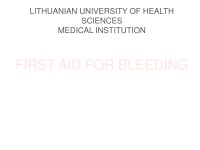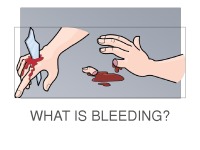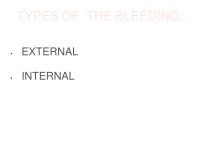First Aid - Bleeding



First aid for bleeding. Lithuanian university of health sciences medical institution by augustė railaitė, 23g Kaunas. What is bleeding? Types of the bleeding. External internal. Signs and symptoms of internal bleeding. Vomitting tender, distended abdomen bleeding from mouth. Classification of external bleeding. Capillary venous arterial. Common causes of bleeding. Traumatic - gunshot wounds, hematoma or bruises. Treatment of bleeding. First aid for minor injuries and nosebleed. Signs and symptoms of heavy bleeding. Thirst faint and giddiness cold skin blurred vision profuse sweating unconsciousness. Useful mnemonic peep. P position the casualty in a position of rest. How to address severe bleeding. First step. Call for help! sanitize your hands if you can. Second step. Lay the injured. Third step. Remove any debris. Fourth step. Apply pressure on the bleeding area to stop severe bleeding. Fifth step. Place a pad. Sixth step. Place more cloths if the bleeding does not stop. Seventh step. Get the injured. First aid bleeding quiz. If someone is bleeding heavily from a wound. No, im sure the bleeding will stop eventually. When someone is bleeding heavily. Put pressure on the wound apply an ice pack to the wound. While. Clean the wound. Which. Pillow a tea towel jeans a frying pan. When. Plug drain hose. Be safe! Sources.
Vomitting tender, distended abdomen bleeding from mouth, rectum.. painful, swollen or deformed extremities signs and symptoms of shock injuries to surface of body.
Traumatic - gunshot wounds, hematoma or bruises, puncture wounds; medical - hemophilia, leukemia, brain trauma, liver disease; medicines (that may be responsible for bleeding) - antibiotics, blood-thinning medications.
Thirst faint and giddiness cold skin blurred vision profuse sweating unconsciousness.
P : position the casualty in a position of rest; e : elevate above the level of the heart; e : expose and examine the wound; p : pressure. apply direct pressure.
Call for help! sanitize your hands if you can. put on surgical gloves if you can. this will help to prevent infection.
Lay the injured person down flat and elevate the legs or place the pillow under the body. cover, if possible, with the blanket. to keep body heat in.
Remove any debris or dirt from the bleeding area withour removing any large chunks that may have caused the damage,.
Apply pressure on the bleeding area to stop severe bleeding.
- Medicine Presentations
- MS PowerPoint 1546 KB
- 2020 m.
- English
- 26 pages (591 words)
- University
- Rūta










